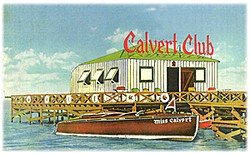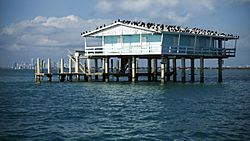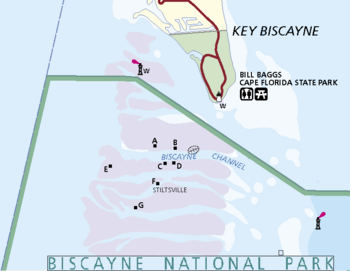Stiltsville facts for kids
Stiltsville is a cool collection of wooden houses built on stilts! You can find them about a mile south of Cape Florida in Miami-Dade County, Florida. These unique homes stand on strong wooden or concrete poles, usually about ten feet above the water. The water around them is pretty shallow, only one to three feet deep when the tide is low.
The Story of Stiltsville
People aren't exactly sure when the first stilt house was built. Most say it was in the early 1930s. But some historians in Dade County believe there were already about a dozen shacks in the area, which people called "the flats," as early as 1922.
Crawfish Eddie's Shack
In 1933, a man nicknamed "Crawfish" Eddie Walker built a shack on stilts over the water. This was around the end of the time when alcohol was banned in the United States. People said he built it to make it easier for gambling, which was allowed if you were one mile offshore. Crawfish Eddie sold bait and drinks from his shack. He was also famous for a dish he called chilau, which was a yummy crawfish soup made with crawfish he caught right under his house!
Two of Eddie's friends, Thomas Grady and Leo Edward, built their own shacks in 1937. More people came to the area because of shipwrecks and channel digging, and more shacks popped up. Some were built by boating and fishing clubs. Local newspapers started calling the area "the shacks" or "shack colony." Sadly, Crawfish Eddie's first shack was destroyed by a big storm called Hurricane King in 1950.
Fun Clubs on the Water
The first social club in Stiltsville was built in the late 1930s and was called the Calvert Club. A fishing club from Miami Beach had its first official trip there in August 1938. The Calvert Club was so popular that they even had postcards printed with its picture!
The Quarterdeck Club
Another club, the Quarterdeck Club, opened in November 1940. It was built on a large boat called a barge by Commodore Edward Turner. This club became super popular after an article about it appeared in Life magazine in 1941. The article said it was an "amazing American community" just for enjoying sunshine, ocean water, and feeling good. It was described as a fancy "play-palace" with a bar, lounge, dining room, and places for yachts to dock.
Newspapers started showing stories and photos of parties with famous people at the Quarterdeck Club. Tourists thought it was a must-see place in Miami Beach, Florida.
There were always rumors about gambling happening there. The club was even checked by police in 1949, but they didn't find any proof of gambling. A hotel owner named Warren Freeman bought the club in 1950. He wanted to make it a very high-class place. He fixed it up and made it bigger, but then Hurricane King hit and damaged it badly. Feeling very sad and having lost a lot of money, Freeman sold what was left.
The club was rebuilt, but it never became as popular as it once was. In 1960, Hurricane Donna damaged most of the buildings in Stiltsville, including the Quarterdeck Club. Then, in 1961, the building was completely destroyed by a fire. The fire burned everything down to the poles. The last owner of the Quarterdeck Club was not allowed to get a building permit in 1967.
Stiltsville: A Party Hotspot
Stiltsville might have looked a bit rough, but in the 1940s and 1950s, it was a very popular spot. Important people like lawyers, bankers, and politicians from Miami came there to relax and have fun. Police would sometimes visit the area, looking for people breaking rules.
Florida Governor LeRoy Collins often visited in the 1950s. He was a guest at Jimmy Ellenburg's house. Jimmy Ellenburg had set up his barge near Crawfish Eddie's in 1939 and was known as the unofficial mayor of Stiltsville. The governor even wrote a note to Jimmy saying, "When the time comes when I say so long to this life, I hope the great beyond seems alot [sic] like your cabin in the sea - Roy Collins."
From the 1950s to the 1960s, Stiltsville's houses became more stylish. Some had cool designs, like the "A-frame" house, the Leshaw House with its unique roof, and the Baldwin, Sessions & Shaw House, which was even shown in a national ad for paints! These three houses, along with the Ellenburg house, were among the seven buildings that were protected in 2003 by the Stiltsville Trust. Most of the houses had porches that went all the way around them. At its busiest in 1960, Stiltsville had 27 buildings!
Miami Springs Power Boat Club
In the late 1950s, a group of twelve workers from the Miami Springs Power Boat Club bought a sunken barge for just $1! They fixed it up, floated it, and pulled it to Stiltsville. There, they placed it on a muddy area and built a structure and docks for their club. Hurricane Betsy caused a lot of damage to the barge in 1965. So, the club members put in strong concrete poles, which are still there today. Thousands of people have visited the Springs House over the years, including Boy Scout troops and Optimist Clubs. Several TV commercials have also been filmed there. It was one of the seven buildings still standing that was included in the Stiltsville Trust of 2003.
Radio Tower on the Water
In 1967, a radio station called WRIZ built radio towers in Stiltsville. These towers were used for broadcasting radio signals. Later, in 1985, it became radio station WRHC. They used the Stiltsville towers for broadcasting during the day until about 1990. Salt water is very good at conducting electricity, which helps radio signals travel farther. This allowed the station to reach a wider area with the same power.
Rules and Protection
The wild, free era of Stiltsville changed after Hurricane Betsy in 1965. Starting in August 1965, the state of Florida made house owners pay $100 each year to rent their small "campsites." No new houses could be built, and if a house was damaged by more than half, it couldn't be rebuilt. New building rules were put in place, and the state stopped businesses from operating there after 1969.
Lease Renewals and Park Expansion
In 1976, the state renewed the leases for $300 a year. But these new leases had an end date: July 1, 1999. A rule in the lease said that any buildings left after that date would be removed, and the owners would have to pay for it.
In June 1980, the government made Biscayne National Park bigger, and Stiltsville became part of the park. In 1985, the state of Florida gave the underwater land in that area to the United States. The Park Service agreed to keep the existing leases, so nothing really changed for the house owners at that time.
At the start of 1992, there were 14 "campsites" with houses in Stiltsville. But after Hurricane Andrew hit on August 24, 1992, only seven buildings survived and were still standing by July 1, 1999.
Saving Stiltsville
As the lease end date got closer, the house owners asked for their leases to be renewed. In the mid-1990s, the park service told them they couldn't renew the leases. They suggested the owners try to get Stiltsville listed on the National Register of Historic Places. Several groups tried to help, but Stiltsville didn't get listed twice. This was mainly because the houses that were left weren't 50 years old yet.
Dr. Paul George, a historian, explained how important Stiltsville was: "It really is an only-in-Miami kind of thing. It had an aura, a rascally mischievous past. But it was also just a place people could go to enjoy getting away. It would be a terrible loss."
Life magazine published another article about Stiltsville in November 1998, 57 years after their first one. It was called "Stiltsville: The residents of a fading Florida community make a stand to save it."
A Big Petition
As a last try, people started a petition to save Stiltsville.
The community's response was amazing! More than 75,000 people asked for Stiltsville to be saved. Because of this, the park service changed its mind. In August 2000, the Park Service announced that they approved a plan to protect Stiltsville.
Under this new plan, the houses would not be torn down. The existing leases would be extended while a plan to preserve them was created.
The Stiltsville Trust
In 2003, a non-profit group called the Stiltsville Trust was created. It included the seven remaining leaseholders, who are now called caretakers, and eight other community members. Their goal was to raise money and fix up the buildings. They wanted to show off the park's ocean resources and support education. They thought the houses could be used for community meetings, a visitor center, research, an artist in residence program, or even a small National Park Service office.
The park service added special straps to the houses to protect them from strong winds during big storms. The caretakers still do basic repairs on their former weekend getaways. However, the Stiltsville buildings are now owned by the National Park Service. They have "no trespassing" signs, and you need permission from the park's boss to visit them if you're not part of the trust.
The Park Service hopes the Stiltsville Trust will help with one of Biscayne National Park's challenges: the park is 95% water, and it's hard for people without boats to visit. According to park superintendent Linda Canzanelli, "A lot of people hear about Biscayne National Park because of Stiltsville. It can be a wonderful educational tool if we can get people out there so we can talk about the local history and marine environment."
The Seven Remaining Houses
- A - Jimmy Ellenburg House
- B - A-Frame House
- C - Baldwin, Sessions & Shaw House
- D - Leshaw House (This one was sadly destroyed by fire on January 11, 2021)
- E - Bay Chateau
- F - Hicks House
- G - Miami Springs Power Boat Club




